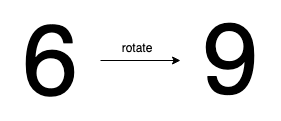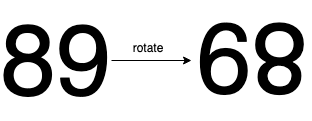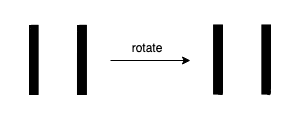[LeetCode] 1056. Confusing Number 混淆的数字
Given a number N, return true if and only if it is a confusing number, which satisfies the following condition:
We can rotate digits by 180 degrees to form new digits. When 0, 1, 6, 8, 9 are rotated 180 degrees, they become 0, 1, 9, 8, 6 respectively. When 2, 3, 4, 5 and 7 are rotated 180 degrees, they become invalid. A confusing number is a number that when rotated 180 degrees becomes a different number with each digit valid.
Example 1:

Input: 6
Output: true
Explanation:
We get `9` after rotating `6`, `9` is a valid number and `9!=6`.
Example 2:

Input: 89
Output: true
Explanation:
We get `68` after rotating `89`, `86` is a valid number and `86!=89`.
Example 3:

Input: 11
Output: false
Explanation:
We get `11` after rotating `11`, `11` is a valid number but the value remains the same, thus `11` is not a confusing number.
Example 4:

Input: 25
Output: false
Explanation:
We get an invalid number after rotating `25`.
Note:
0 <= N <= 10^9- After the rotation we can ignore leading zeros, for example if after rotation we have
0008then this number is considered as just8.
这道题定义了一种迷惑数,将数字翻转 180 度,其中 0, 1, 8 旋转后保持不变,6变成9,9变成6,数字 2, 3, 4, 5, 和 7 旋转后变为非法数字。若能将某个数翻转后成为一个合法的新的数,就说这个数是迷惑数。这道题的难度并不大,就是考察的是遍历整数各个位上的数字,使用一个 while 循环,然后用 mod10 取出当前最低位上的数字,将不合法的数字放入一个 HashSet 中,这样直接在 HashSet 中查找一下当前数字是否存在,存在直接返回 false。不存在的话,则要进行翻转,因为只有6和9两个数字翻转后会得到不同的数字,所以单独判断一下,然后将当前数字拼到 num 的最低位即可,最终拼成的 num 就是原数字 N 的翻转,最后别忘了比较一下是否相同,参见代码如下:
解法一:
class Solution {
public:
bool confusingNumber(int N) {
int num = 0, oldN = N;
unordered_set<int> invalid{{2, 3, 4, 5, 7}};
while (N > 0) {
int digit = N % 10;
if (invalid.count(digit)) return false;
if (digit == 6) digit = 9;
else if (digit == 9) digit = 6;
num = num * 10 + digit;
N /= 10;
}
return num != oldN;
}
};
这也可以用一个 HashMap 来建立所有的数字映射,然后还是用一个变量 oldN 来记录原来的数字,然后遍历N上的每一位数字,若其不在 HashMap 中,说明有数字无法翻转,直接返回 false,否则就把翻转后的数字加入 res,最后只要看 res 和 oldN 是否相等即可,参见代码如下:
解法二:
class Solution {
public:
bool confusingNumber(int N) {
unordered_map<int, int> m{{0, 0}, {1, 1}, {6, 9}, {8, 8}, {9, 6}};
long oldN = N, res = 0;
while (N > 0) {
if (!m.count(N % 10)) return false;
res = res * 10 + m[N % 10];
N /= 10;
}
return res != oldN;
}
};
下面来看一种双指针的解法,这里先用一个数组 rotate 来按位记录每个数字翻转后得到的数字,用 -1 来表示非法情况,然后将数字 N 转为字符串,用两个指针 left 和 right 分别指向开头和末尾。用 while 循环进行遍历,假如此时 left 和 right 中有任何一个指向的数字翻转后是非法,直接返回 false。然后看 left 指向的数字翻转后跟 right 指向的数字是否相同,若不同,则将 res 标记为 true,然后移动 left 和 right 指针,最终返回 res 即可,参见代码如下:
解法三:
class Solution {
public:
bool confusingNumber(int N) {
bool res = false;
vector<int> rotate{0, 1, -1, -1, -1, -1, 9, -1, 8, 6};
string str = to_string(N);
int n = str.size(), left = 0, right = n - 1;
while (left <= right) {
if (rotate[str[left] - '0'] == -1 || rotate[str[right] - '0'] == -1) return false;
if (rotate[str[left] - '0'] != (str[right] - '0')) res = true;
++left; --right;
}
return res;
}
};
Github 同步地址:
https://github.com/grandyang/leetcode/issues/1056
类似题目:
参考资料:
https://leetcode.com/problems/confusing-number/











【推荐】还在用 ECharts 开发大屏?试试这款永久免费的开源 BI 工具!
【推荐】国内首个AI IDE,深度理解中文开发场景,立即下载体验Trae
【推荐】编程新体验,更懂你的AI,立即体验豆包MarsCode编程助手
【推荐】轻量又高性能的 SSH 工具 IShell:AI 加持,快人一步
· 从问题排查到源码分析:ActiveMQ消费端频繁日志刷屏的秘密
· 一次Java后端服务间歇性响应慢的问题排查记录
· dotnet 源代码生成器分析器入门
· ASP.NET Core 模型验证消息的本地化新姿势
· 对象命名为何需要避免'-er'和'-or'后缀
· “你见过凌晨四点的洛杉矶吗?”--《我们为什么要睡觉》
· 编程神器Trae:当我用上后,才知道自己的创造力被低估了多少
· C# 从零开始使用Layui.Wpf库开发WPF客户端
· C#/.NET/.NET Core技术前沿周刊 | 第 31 期(2025年3.17-3.23)
· 接口重试的7种常用方案!
2019-03-28 [LeetCode] 855. Exam Room 考试房间
2018-03-28 [LeetCode] 726. Number of Atoms 原子的个数
2017-03-28 [LeetCode] Perfect Number 完美数字
2016-03-28 [LeetCode] 255. Verify Preorder Sequence in Binary Search Tree 验证二叉搜索树的先序序列
2015-03-28 [LeetCode] 45. Jump Game II 跳跃游戏之二